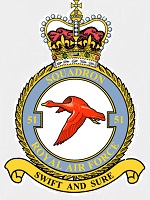Corgi AA37209 RAF Handley Page Halifax B.III Heavy Bomber - LV937/MH-E "Expensive Babe", No.51 Squadron, Snaith, England, March 1945 - Halifax Centurion (1:72 Scale)
"Swift and Sure"
- Motto of No. 51 Squadron
 The Handley Page Halifax was one of the British front-line, four-engine heavy bombers of the Royal Air Force during the Second World War. A contemporary of the famous Avro Lancaster, the Halifax remained in service until the end of the war, performing a variety of duties in addition to bombing. The Halifax was also operated by squadrons of the Royal Australian Air Force, Royal Canadian Air Force, Royal New Zealand Air Force and Polish Air Force.
The Handley Page Halifax was one of the British front-line, four-engine heavy bombers of the Royal Air Force during the Second World War. A contemporary of the famous Avro Lancaster, the Halifax remained in service until the end of the war, performing a variety of duties in addition to bombing. The Halifax was also operated by squadrons of the Royal Australian Air Force, Royal Canadian Air Force, Royal New Zealand Air Force and Polish Air Force.
The Halifax entered service with No. 35 Squadron RAF at RAF Linton on Ouse in November 1940 and its first operational raid was against Le Havre on the night of 11-12 March 1941. In service with RAF Bomber Command, Halifaxes flew 82,773 operations, dropped 224,207 tons of bombs and lost 1,833 aircraft. (Wings Encyclopedia of Aviation, Orbis, 1979) In addition to bombing missions, the Halifax served as a glider tug, electronic warfare aircraft for No. 100 Group RAF and special operations such as parachuting agents and arms into occupied Europe. Halifaxes were also operated by RAF Coastal Command for anti submarine warfare, reconnaissance and meteorological roles.
Total Halifax production was 6,176 with the last aircraft delivered in November 1946. In addition to Handley Page, Halifaxes were built by English Electric, Fairey Aviation, Rootes Motors and the London Aircraft Production Group. Peak production resulted in one Halifax being completed every hour.
Post-WWII, Halifaxes remained in service with the RAF Coastal Command and RAF Transport Command and the
Armee de l'Air until early 1952. The Pakistan Air Force which inherited the planes from the RAF continued to use the type until 1961. A transport/cargo version of the Halifax was also produced, the Handley Page Halton.
Pictured here is a 1:72 scale replica of a RAF Handley Page Halifax B.III heavy bomber nicknamed "Expensive Babe", that was attached to No.51 Squadron, then deployed to Snaith, England, during March 1945.
Sold Out!
Dimensions:
Wingspan: 17-1/4-inches
Length: 12-inches
Release Date: May 2019
 Historical Account: "Expensive Babe" - One of the most significant factors in reducing the effectiveness of Luftwaffe bombing operations during the Second World War was their lack of a capable heavy bomber which could be deployed in large numbers. By comparison, the Allies were almost spoiled for choice and following the introduction of the four engined Short Stirling, Bomber Command's operations took on a new dimension of offensive capability. The second four engined 'Heavy' to enter squadron service was the Handley Page Halifax, an aircraft which would go on to see constant development throughout the rest of the war and result in more than 6,000 aircraft eventually being produced.
Historical Account: "Expensive Babe" - One of the most significant factors in reducing the effectiveness of Luftwaffe bombing operations during the Second World War was their lack of a capable heavy bomber which could be deployed in large numbers. By comparison, the Allies were almost spoiled for choice and following the introduction of the four engined Short Stirling, Bomber Command's operations took on a new dimension of offensive capability. The second four engined 'Heavy' to enter squadron service was the Handley Page Halifax, an aircraft which would go on to see constant development throughout the rest of the war and result in more than 6,000 aircraft eventually being produced.
Underlining the incredibly dangerous missions these mighty aircraft were designed to undertake, out of this number, only five Halifax's would manage to set the impressive mark of completing 100 or more operational sorties and taking their place in the annals of Bomber Command history. Handley Page Halifax B.III LV937 "Expensive Babe" was one of those five aircraft - entering RAF service with No.578 Squadron in March 1944, she only served one month with this unit, before being transferred to No.51 Squadron at Snaith the following month. She would see extensive service with this squadron over the next few months, recording her landmark 100th operation on 25th March 1945, on a raid to Osnabruck. Highlighting the international contribution to Bomber Command during WWII, the crew on this significant date was made up of Australian, New Zealand and British airmen, who were all greeted by the station commander on their return. As well as the nose artwork and impressive mission tally, this Halifax also features a single white swastika on the port front fuselage and represents a Luftwaffe Ju88 claimed as destroyed.








